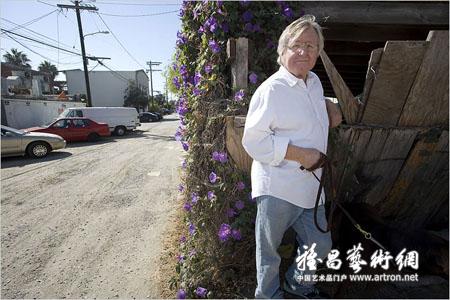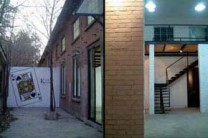Economic Realities Press on Artists' Outdoor Eden
2011-04-15 11:31:21

Laddie John Dill at the fence of the outdoor studio he shares with Ed Ruscha in Los Angeles.
When the artist Laddie John Dill fenced in a part of the railroad easement behind his studio in the dilapidated beach community of Venice nearly three decades ago, it was less to stake a claim to an otherwise unwanted parcel of real estate than to keep at bay, he said, a growing coterie of drug dealers, prostitutes and vagrants who were encroaching on his work space.
He was soon joined by the painter Ed Ruscha, and together they have toiled for 25 years in the open-air studio, which is still ringed with the detritus of homeless people who camp in the dirt alley outside the fence.
In the rapidly reviving Venice of today, and in a city where parking is more fervently debated than air quality, it seems almost too predictable that the City of Los Angeles wants to tear down the fence, pave the space and, yes, put up a parking lot.
The project has quickly emerged as a fight between the artistic values that led to the renewal of Venice and the commercial interests that are reshaping the community’s character.
“It’s not like there hasn’t been a chance for fair public hearings about this,” he said. “That structure is basically a lean-to that is far from habitable and safe. If somebody called the buildings department, that would put the whole thing to an end.”
“After the railroad line stopped back there, and Venice began its slow deterioration, this was a really rough part of town,” Mr. Dill said. Now, however, as the boulevard on the other side of the alley has become populated with restaurants, clothing boutiques and a Pinkberry cafe, “this whole thing is symbolic of the gentrification of Venice.”
City bulldozers are expected to begin work on the 100-space parking project soon after a ground-breaking ceremony on Thursday. That has led the owner of the warehouse leased by the two artists to begin preparing a lawsuit seeking to stop the project.
Bill Rosendahl, the city councilman who represents the district, said in an interview that he met with Mr. Ruscha at the studio on Sunday, and that the city would delay destruction of the fenced-in artists’ enclave at least until March, allowing for time for a compromise solution.
“But this is city land that will be turned into a strip of parking,” he said. “My hope is we can work out something with the landlord,” he continued, to allow the artists to move their outdoor workspace to the other side of the building, which faces Electric Avenue.
Nicole Slayton, a lawyer who is the daughter of the property owner, Robert Slayton, said the city knew that the artists were using the property before it bought the rights to the railroad easement and that the artists’ use of the space is therefore protected.
“We have asserted that right, but they have stopped communicating with us,” Ms. Slayton said of the city. Regarding Mr. Rosendahl’s proposed compromise, she added, “We have no trust that they will follow through on anything.”
All of which has prompted a certain amount of “Can we all get along?” hand-wringing. Aldis Browne, an art dealer who is the co-chairman of the Venice Neighborhood Council arts committee and also a director of the Venice Chamber of Commerce, said he believed that there must be a way to work out the dispute.
“I personally don’t see this as something that has to be as extreme as ‘Does Venice care about art or parking?’ ” Mr. Browne said.
Mr. Dill and Ms. Slayton said their concerns went beyond the loss of the outdoor studio. The alleyway, which lies between Electric Avenue and Abbot Kinney Boulevard, has drainage problems, they say, that have not been adequately addressed by city engineers. In addition, the proposed parking abuts the rear entrance to the warehouse and would therefore block a mandated fire exit.
Mr. Dill, informed of the city’s proposed compromise — moving the outdoor workspace — said that still would not address the drainage or access concerns, not to mention that an outdoor studio on the east side of the building receives different light from one on the west side.
Mr. Rosendahl said the plans allowed for adequate exit space and would address drainage problems. And, he noted, the project has been on the city’s agenda for most of the 20 years since it bought the rights to the property from a private owner, who had acquired it from the railroad.
Mr. Ruscha, whose paintings are recognizable for their frequent inclusion of words or phrases across the landscape or scene and are part of the permanent collections of the Museum of Modern Art and the Los Angeles County Museum of Art, rarely gives interviews. He was said by a representative at the Gagosian Gallery to be traveling on Monday and unavailable for comment.
“We respect and admire and consider Ed Ruscha to be a treasure of Venice,” Mr. Rosendahl said. “I told him on Sunday that this was the beginning of a discussion, and that we want to keep him there.”
Other local property owners are less sympathetic. Andy Layman, president of the Chamber of Commerce, has also been around Venice for decades, having bought and renovated a run-down hotel in the 1980s.
“It’s not like there hasn’t been a chance for fair public hearings about this,” he said. “That structure is basically a lean-to that is far from habitable and safe. If somebody called the buildings department, that would put the whole thing to an end.”

 黄琦
黄琦 测试用艺术
测试用艺术
